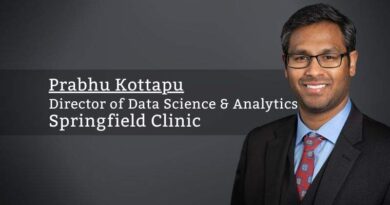Imbio-Helping the population breathe with patient-centered AI solutions
An estimated 25 million people in the U.S. suffer from various lung diseases, some of which can be life-threatening. And unfortunately, far too many people are unaware of their lung condition. It’s estimated that only 50 percent of patients living with Chronic Obstructive Pulmonary Disease (COPD), a breathing disorder that destroys regions of the lungs, have been diagnosed. Similarly, only about half of people with lung fibrosis, a potentially fatal condition, have been diagnosed. About 23 percent of lung cancer cases are diagnosed at an early stage when it is most treatable. Recent technological innovations involving AI in medical imaging and diagnostics tests are key to manage respiratory health and assist clinical interventions for disease prevention. Imbio, a market-renowned medical imaging diagnostics company is at the forefront of transforming the way lung diseases are detected, diagnosed and treated.
Designed by physicians, for physicians, Imbio was conceived with a strong focus on COPD and lung fibrosis. Over the years, the company has expanded to a broader lung and cardiothoracic portfolio, but in all cases, Imbio takes a patient and physician-centric view of its products. Imbio’s suite of cutting-edge, AI and ML-based medical image analysis solutions are known for aiding detection of lung and cardiothoracic abnormalities from patients’ CT scans. The solutions enable automated population screening for lung diseases. Once detected, Imbio provides rich quantitative data and visualization of the patient condition to more accurately stage disease, assist treatment decisions, and track patient status including response to therapies.
Designed by Physicians, for Physicians
“When we say our products are designed by physicians, for physicians, it reflects our acknowledgment of two things. First, any medical device, AI software or otherwise, needs to start with a clinical problem that if solved, benefits patients,” says David Hannes, Imbio’s CEO. “Secondly, physicians lend the greatest insight into what solutions are needed.” According to him, the medical imaging field works to create an AI-enabled medical device that demonstrably helps a physician make a diagnosis and treatment decision for patients that would have otherwise been difficult or uncertain. Elucidating on this, Hannes points to Imbio’s work in COPD. “We started with ‘Lung Density Analysis’ technology from the University of Michigan, which their physicians and imaging scientists developed because they wanted to better understand their COPD patients,” Hannes adds. “They wanted to be able to detect both early-stage bronchitis, which can be difficult to call with confidence on imaging, and end-stage emphysema. They also wanted to be able to specifically quantify or stage their patients at a time when the standard of care was simply calling COPD ‘mild, moderate, or severe’ COPD.”
Today, Imbio has productized and gained regulatory clearance for fully-automated Lung Density Analysis for the general detection and diagnosis of COPD. The firm has also partnered with Olympus Medical in bringing Endobronchial Valves (EBV), a new treatment for late-stage COPD patients, to market. Imbio provides the Olympus ‘SeleCT’ analysis for performing a detailed analysis of emphysema severity, location and lung structure integrity to qualify potential patients for EBV procedures. “So now Imbio offers providers an AI-enabled solution that helps patients and can help providers grow their interventional pulmonology practices in a new procedure,” Hannes says. The Imbio product suite can automatically screen every patient CT for COPD/emphysema. It can provide quantitative rather than qualitative baseline diagnosis. Finally, it qualifies patients for a new therapy, and lastly, provides quantitative follow-up for both patients being monitored, and those who have undergone therapy.
Imbio’s overall portfolio is designed to enable a holistic Lung Health Program.
Adding to the rising popularity of algorithms-driven workflows, Hannes believes care providers and practitioners can rest assured as “the algorithms are not here to replace radiologists. While there are simple tasks that AI can take off the plate of radiology, the algorithms are largely complementary to human expertise by performing tasks that the human eye can’t.” He says, “AI adds hard data to otherwise qualitative interpretation, and can provide expert-level AI capability when an expert such as a specialty thoracic radiologist is not available. Moreover, our focus at Imbio is not on replacing a physician, but on using AI to enable clinical solutions that help multidisciplinary care teams detect patients, manage care, and grow their practice.”
Deciding where to start is often a barrier, but it doesn’t have to be
The scope of medical imaging AI solutions span a vast clinical spectrum from stroke and cancer to heart disease, lung diseases and many other acute and chronic conditions. “Physicians will often say to us ‘there’s so much AI coming out, we don’t know where to start’. And I always respond, ‘you’re not alone’. Several surveys of physicians have highlighted ‘deciding where to start’ as a common barrier to broader AI adoption. But the reality is it doesn’t have to be. My best advice is always to start in two places,” explains Hannes.
The first area to start would be with productivity tools. AI makes tasks more efficient in many industries and healthcare is no exception. There are imaging AI tools specifically designed to perform diagnostic reading tasks that can take physicians – most often Radiologists – 20, 30 or more minutes, and instead, execute them in seconds. Then the Radiologist can apply their expertise to overread and confirm the AI results quickly. A good example of this is Imbio’s upcoming aortic measurement AI. Measuring the thoracic aorta is a critical task to determine if a patient has an aneurysm, which can potentially lead to a life-threatening dissection. Yet the standard of care is to take 7 different measurements along the aorta and these measurements need to be very exact with accuracy measured in millimeters. This task can take a radiologist 30 minutes or more to do with the desired accuracy. Imbio’s AI algorithm can automatically detect and measure the aorta at all the landmarks in under a minute. When there’s a shortage of Radiologists, these types of tools can be no-brainers to give radiologists back the time that they need, and hopefully, help be part of the solution to growing physician burnout.
The second place to start is by targeting a specific clinical practice area and equipping that practice with AI tools that improve the quality of care and often, can help grow the practice for an institution. Imbio’s COPD and emphysema program can serve patients and grow interventional pulmonology practices for providers. Additionally, Imbio’s overall portfolio is designed to enable a holistic Lung Health Program. The firm is currently launching pilots with leading hospitals, utilizing Imbio’s entire portfolio to screen for a broad range of lung and cardiothoracic conditions, refer patients into appropriate treatment clinics within the health system (e.g., ILD, COPD, nodule clinics), and provide quantitative AI to support follow-up care. And it’s an excellent time for providers to advance and grow their lung care programs because the last five years have brought multiple new treatments for COPD, emphysema, lung fibrosis, pulmonary embolisms and other conditions for patients in need.
The last piece of making it easy to start is really on Imbio more than the providers, and it’s that Imbio has made the solutions agnostic to any brand of CT scanners and flexible to be deployed through partners who may already be present inside the health system. In the U.S., Imbio offers deployment through partners such as Aidoc, Siemens and Nuance. “With Nuance, as an example, we are further integrating to take end-to-end Lung Health programs to the next level. In the end, our focus remains on delivering meaningful clinical solutions for patients and the physicians who care for them,” says Hannes.



